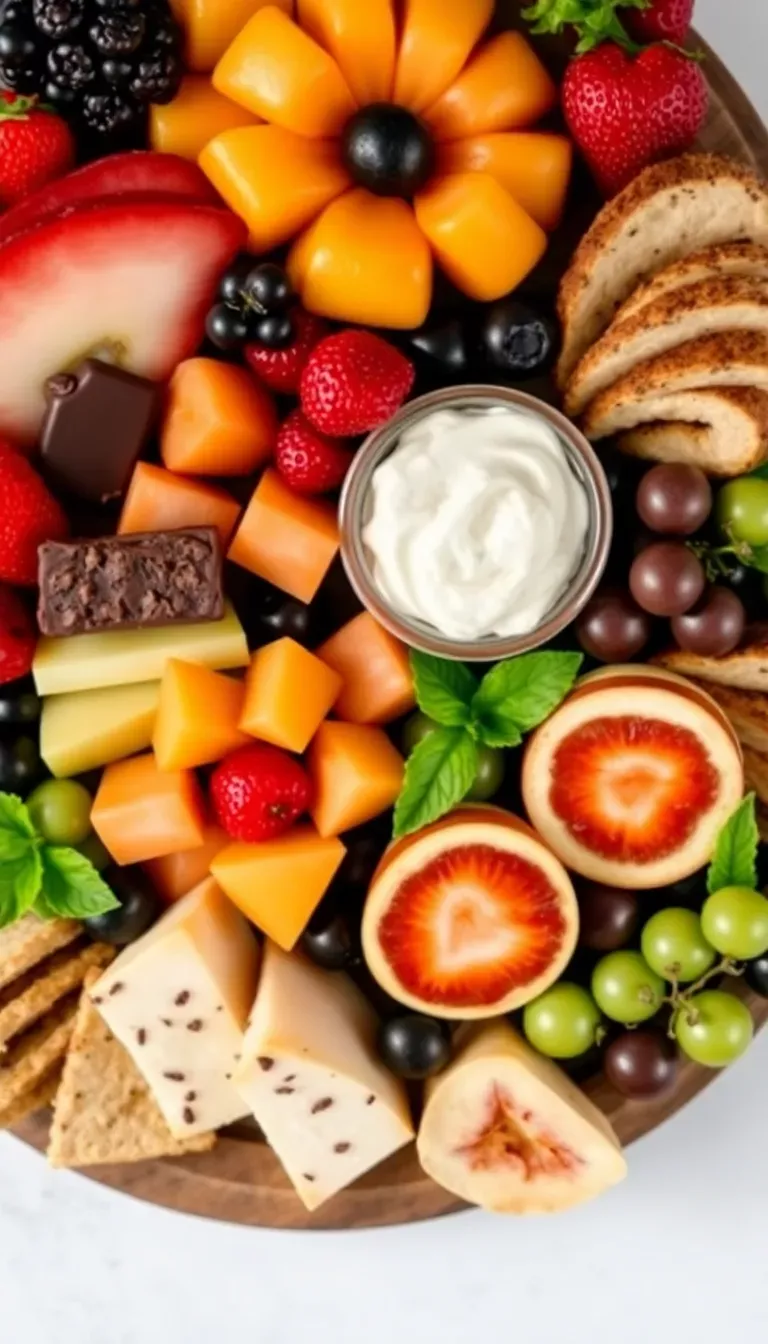Imagine a platter so irresistible that your guests forget their phones exist. A fruit and chocolate charcuterie board isn’t just food—it’s an experience. Sweet, salty, crunchy, creamy—every bite hits different.
Whether you’re hosting a party, impressing a date, or just treating yourself, this board delivers. No cooking skills? No problem.
It’s so easy, even your cat could assemble it (but please don’t let them). Ready to make something that’ll have people begging for the recipe? Let’s go.
Why This Recipe Works
This isn’t just a bunch of fruit and chocolate thrown on a board.
It’s a flavor bomb designed for maximum satisfaction. The combination of fresh fruit cuts through the richness of the chocolate, while nuts and crackers add texture. It’s versatile—swap ingredients based on what’s in season or what’s left in your pantry.
Plus, it looks Instagram-worthy with zero effort. Who doesn’t love food that’s both delicious and low-maintenance?
Ingredients You’ll Need
- Fruits: Strawberries, grapes, apple slices, banana chunks, dried apricots, or whatever’s in your fridge.
- Chocolate: Dark, milk, or white chocolate bars (or all three—no judgment).
- Extras: Almonds, cashews, pretzels, marshmallows, or cookies for crunch.
- Dips: Nut butter, caramel sauce, or yogurt for dipping.
- Cheese (optional): Brie or goat cheese if you’re feeling fancy.
How to Assemble It (Step-by-Step)
- Pick your board: Use a wooden plank, slate, or even a baking sheet. Size depends on how hungry you are.
- Arrange the chocolate: Break bars into chunks or melt some for drizzling.
Pro tip: Use a mix of shapes and sizes.
- Add the fruit: Slice larger fruits (like apples) for easy grabbing. Keep berries whole for drama.
- Scatter the extras: Nuts, pretzels, and cookies go in the gaps. Fill every inch—this isn’t a time for restraint.
- Dips and drizzles: Place small bowls of nut butter or caramel on the board.
Drizzle melted chocolate over everything like you’re Picasso.
- Cheese (if using): Add slices or a whole wheel for a savory twist.
Storage Instructions
If by some miracle there’s leftovers, store them in an airtight container in the fridge. Fruit will last 1-2 days, but the chocolate might get a little sad. Re-melt it for drizzling later. FYI, the board won’t survive a second round with hungry friends around.
Why This Board is a Game-Changer
It’s customizable, quick, and universally loved.
The fruit adds vitamins, the chocolate gives a mood boost, and the nuts pack protein. It’s also a sneaky way to get kids (or picky adults) to eat fruit. Plus, it’s the only “cooking” you’ll do that doesn’t involve turning on the stove.
Win-win.
Common Mistakes to Avoid
- Soggy fruit: Pat berries dry before arranging. No one likes a watery board.
- Too much chocolate: Balance is key. Unless you’re hosting a chocoholics anonymous meeting, ease up.
- Ignoring colors: Mix bright fruits with dark chocolate for contrast.
Aesthetics matter, people.
- Overcomplicating: This isn’t a Michelin-star dish. Keep it simple.
Ingredient Alternatives
Out of strawberries? Use raspberries.
Hate dark chocolate? Swap for white. Allergic to nuts?
Seeds work too. The beauty of this board is its flexibility. IMO, the only non-negotiable is the chocolate—because life’s too short for bland snacks.
FAQs
Can I make this ahead of time?
Yes, but assemble it 1-2 hours max before serving.
Fruit oxidizes, and no one wants brown apples.
What’s the best chocolate for melting?
Dark or milk chocolate with 60-70% cocoa works best. Avoid cheap baking chips—they seize up like awkward teenagers.
How do I keep bananas from browning?
Toss them in a bit of lemon juice or add them last-minute. Or just embrace the rustic look.
Can I use frozen fruit?
Technically yes, but thaw it first.
Unless you’re going for a slushie vibe.
Is this kid-friendly?
Absolutely. Kids love assembling their own bites. Just skip the wine pairings.
Final Thoughts
This fruit and chocolate charcuterie board is the lazy person’s gourmet masterpiece.
It takes minutes to make, requires zero skill, and disappears faster than your motivation to gym. Whether you’re hosting or just treating yourself, it’s a guaranteed hit. Now go forth and snack like royalty.






